In Leviticus we find the Hebrew word tame, טָמֵא, meaning “uncleanliness.” Through the metaphors of Leviticus, tame appears to describe an “uncleanness” of a “moral” type. Typically it is understood as describing something or someone that is “ritually impure.” This, I will posit, is a meaning much closer to a contemporary Jewish understanding of what is “offensive,” “obscene,” “intolerable” or “evil.” This seems true at least as the Hebrew word tame appears in many contexts in the Hebrew Bible. Here we focus on Leviticus.
In other words “evil,” from a Jewish perspective, is Aryans or Whites if specifically as a proud and competing group as opposed to a compliant genetic, wealth or power resource. To complicate matters further the word for “unblemished” or “clean” applying to, for example, animals suitable for sacrifice to Yahweh is tamim, תָּמִים. Tamim, meaning also “complete” or “sound,” is at least phonetically similar to tame.[1]
If the words are related, however, it tends to follow a certain logic that emerges in Leviticus where by sacrificial animals are given to Yahweh or Jewry and his priests but made profane and forbidden to the Aryan Israelites. Here it is implied a sexual competition where Jewish eugenic “consumption” of desired “unblemished” genetic Aryan stocks is good, while the same “consumption” or breeding among the Israelite herd is bad. Regardless, consistent with a contemporary Jewish use of the word “offensive,” it even appears suggested that tame or “uncleanliness” is only cured by “admixture.”
The first appearance of the word tame in the Hebrew Bible occurs as a verb and refers to the Canaanites Shechem’s “defilement” of Dinah, who is indicated esoterically as a Jewess. This enrages the sexually jealous proto-Jews Simeon and Levi, compelling them to revenge against the Canaanites, even though its generally considered likely Shechem, who later seeks to marry Dinah, merely slept with her. Nevertheless, its most insightful use appears in Leviticus.

Leviticus 15 begins: “Yahweh said to Moses and Aaron, ‘Say to the Israelites, ‘When any man has a bodily discharge, the discharge is unclean. This uncleanness is from his discharge, whether his body allows the discharge to flow or blocks it. So his discharge will bring about uncleanness.’” Again there is actually no reason to believe that either Yahweh or Moses believe that this mysterious “discharge” is “unclean.” Rather this is simply what Yahweh is telling his serpent-wielding priests to say who we have already linked to figures like Mercury, the God of Deceivers.
“Discharge,” in this context, is commonly guessed to mean some sort of unnatural discharge, occurring from illness. However, again, there is actually no reason to believe this. The word translated into the English as “discharge” here is zub, זוּב, meaning “gush” or “flow.” More likely it is a reference to semen, possibly even offspring, especially when applied to women, as we will see.
Zub is the verb used in the repeated Biblical phrase “ a land flowing with milk and honey” which this study recognizes as Aryan sexual resources. Of 42 occurrences of zub in the Hebrew Bible, half appear in this famous phrase. Milk, if not a reference to a woman’s milk, in fact, might be a reference to semen drawing from Sumerian inspiration where, for instance, Dumuzid’s semen is described as milk. As likely though it is a reference to Whiteness as this study discusses.
Jeremiah 49:4, when Yahweh, in characteristic fashion, is assuring the Aryan Ammonites he will destroy them, zub is commonly translated in the English as “fruitful.” There it says: “Why do you boast of your valleys, your valleys so fruitful, O faithless daughter?” Only 16 times in Leviticus, once in Numbers and once in Samuel is it translated as a bodily “discharge” with negative insinuations. The closely related zob, זוֹב, ostensibly meaning “an issue of fluid,”is also translated “as discharge” 13 times but only in Leviticus.
Zub is also used to refer to the flowing of waters an element that becomes associated with Aryan blood in the ancestral sense of that word. The Jordan river for example appears to emerge as a metaphor for a genetic flow from northern Aryan Galilee to the infertile deserts and dead sea of Judea. This is especially true in Joshua’s crossing in Joshua 3 and Jesus’s Baptism. Whether with Moses in the basket of bulrushes, Jesus’s baptism or Joshua’s crossing into Canaan as a brutal conqueror, we see a metaphor for “submergence,” “crossing” or admixing with Aryan lines.
The word Jordan appearing from the Hebrew Yarden, יַרְדֵּן, conveys a sense of “flowing.” It is taken from yarad, יָרַד, meaning to “descend,” “come down,” “fall,” “dissolve,” “flowing down” or “pour down.” This study speculates that the Semitic word Ab, meaning “father” in most Semitic languages including Hebrew,[2] is taken from the ancient Sumerian word Ab meaning both “semen” and “fresh water.” Possibly as well eb, אֵב, meaning “freshness” or “verdant” in the Biblical Hebrew and “fruit” in the Aramaic is related. Regardless here it is understood as the semen of the water God Enki which this study identifies as Aryan. Hence water emerges as metaphor in JEM for Aryan continuance or bloodlines.
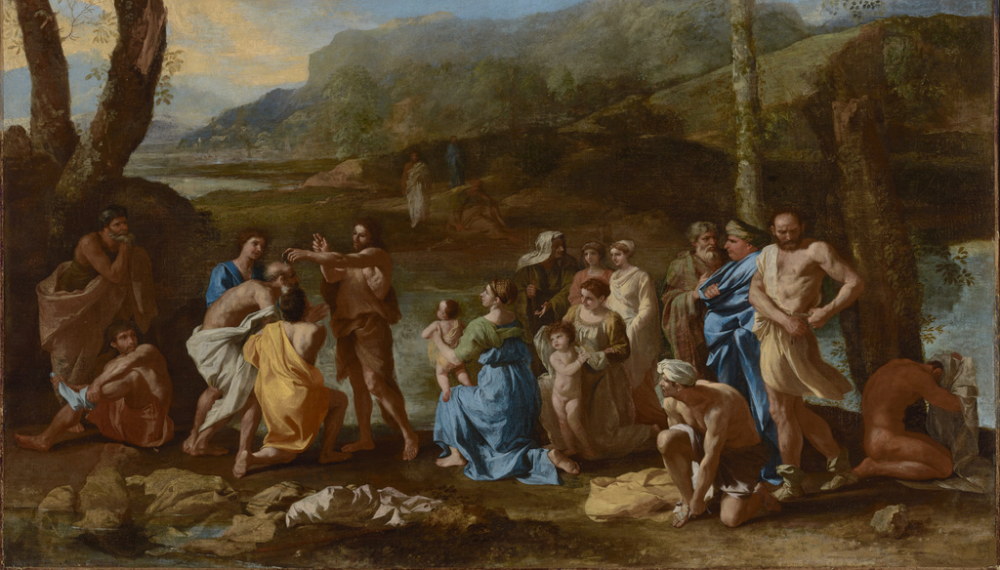
In fact in Leviticus 15:16 that zob means “semen” or even “offspring” appears to become explicit. There, after several lines of discussing this unknown discharge, abruptly we enter a discussion of semen, where the appearance of semen is treated with the same or similar commands. There it says “when a man has an emission of semen (zera), he must bathe his whole body with water, and he will be unclean until evening.” Hence perhaps the Israelites are being told their seed, “fruit” and very continuance is unclean. In fact the word zera, זֶרַע, here may mean “sowing,” “seed” or “offspring”
Meaningfully the Hebrew word “tame” reoccurs in the repeated phrase “will be unclean to evening.” This phrase reoccurs in Leviticus and Numbers, particularly in Leviticus 15. This is meaningful because the word used here for evening is ereb, עֶרֶב. It is nearly identical to ereb, עֵרֶב, meaning “Arabia,” “mixture” and “mixed company” in the Biblical Hebrew. The likelihood that the repeated phrase “will be unclean to evening” means also “will be unclean to racial admixture” will become more pronounced when we review a striking leprosy metaphor occurring in Leviticus. Here the metaphor appears to be between the darkening of light in the sky and the darkening of race. For instance, the related Hebrew word arab, עָרַב, means “to become evening” or “grow dark.”
The metaphor of “evening as a Jewish goal” or as a means to “cleanliness” does not appear to be unique here. For instance, the word Jerusalem, the name of the holy city of Judaism which King David claimed as the capital of Judea, also appears to be a reference to evening or dusk. Here the city is consciously renamed by the conquers replacing its earlier name Jesub, surmised as an indigenous ethnic name. Indeed, generally it is posited that Jerusalem takes its name from Shalim or Shalem, a Canaanite God of dusk.
From our review of Revelation, we will remember “New Jerusalem” is understood as the final destination of Christians, where only the “lamb is the lamp.” All of this is consistent with a reoccurring affinity shown for the chthonic and nocturnal in JEM. To be clear, what appears to be described here is the “evening” or “autumn” of an Aryan people or civilization, understood as occurring by a racial intermixture, with Jewry as effectively a shepherding “God of dusk.” Hence the notion that leading and “observant” Jews are oblivious to this phenomena, let alone their role in them, is shown patently false in Leviticus.
Another reference to Shalem or evening may appear in Leviticus with the repeated word Shelem. Shelem, שֶׁלֶם, means “peace offering” or a “sacrifice for alliance or friendship.” It is understood as likewise derived from the name of the deity Shalem. Indeed the meaning of the name Jerusalem is often proposed to mean city of peace. Specifically it is the word given to animals sacrificed to Yahweh whom we understand as symbols representing Aryans. It derives from the word shalam, שָׁלַם, meaning “amends,” “to be complete” or “sound.” Shalam is believed to be the root of Shelomoh, שְׁלמֹה, or Solomon, the prodigal Jewish king and son of David. It seems very likely, as well, shalam is related to the common Jewish greeting Shalom meaning “complete,” “soundness” and “peace.” Hence this greeting becomes to us something of a JEM laden curse. This returns to our discussion about the right not to be offended in our own lands. In the interim, the Apollonian response to this greeting is a polite and smiling “Shahar.” Shahar is Shalem’s brother, the Aryan God of Dawn. If we are to tolerate their Religion, they are to tolerate ours.

In Leviticus 15:18, Jewish sexual jealousy is shown so intense, it even says: “if a man lies with a woman and there is an emission of semen, both must bathe with water, and they will remain unclean until evening.” Here we remember there is a distinction between man and woman or Adam and Eve, and Yahweh or Jewry, who comes to represent, in a sense, a “third sex,” the Priest. Leviticus describes how the man’s “discharge” is unclean, as well as the woman’s menstruation and that after any occurrence they must ritually clean themselves or atone for it, after which the will “not be clean until evening.” That the woman’s menstruation is unclean may be an objection to her fertility. But that’s likely not the case, particularly as we understand Jews desiring to admix with select Aryans or “Sarahs” and “Rachels.”
Rather the word her for menstruation is niddah, נִדָּה, meaning simply “impurity.” It is commonly used in the Hebrew Bible with no intended reference to a woman’s menstruation nor with any reference to menstruation appearing in English translations. In Leviticus when beginning this discussion on “menstruation” it says: “When a woman has a discharge [zob] consisting of blood [dam] from her body [basar], she will be unclean [niddah] due to menstruation [niddah] for seven days, and anyone who touches her will be unclean [tame] until evening [ereb].”
Above the Hebrew word dam, דָּם, for blood is an element of the word for man or Adam, אָדָם. Here, I argue, it should be understood as blood in the ancestral sense of the word. The word basar for body is similar. In the Hebrew Bible it is commonly translated as flesh but here in the sense of “one’s flesh and blood.” Indeed, in the Hebrew Bible it is also translated on occasion as “men,” “man,” “mankind,” and “person.” Hence it seems likely, especially in light of other metaphors appearing in Leviticus and throughout JEM, the unclean menstruation being described in Leviticus is a reference to “Adamic” or Aryan offspring.
Atonement, for both men and women, guilty of “discharges” or “menstruations” will involve, of course, meeting Yahweh at the Tent of Meeting and suggestively sacrificing turtledoves and pigeons, as sin offerings and burnt offering. The word used here is tor, תּוֹר, which may mean bull in Aramaic. Here, though, it’s worth noting that a word close to goy, gozal, גּוֹזל, appears twice in the Hebrew Bible as a reference to a pigeon or young bird.
In Genesis 15:9 a gozal is offered by the man who will become known as Abraham, as a sacrifice to Yahweh. Of course this study argues the case that the dove, whether as a symbol of the Holy Spirit descending of the Jewish Christ during baptism or as a bird sacred to Ishtar and Venus, is a symbol of the Aryan. Regardless, this sacrifice appears to represent another effort of Israelites to purge themselves of “discharge” or their Aryan seed or offspring and achieve the “purification” of “ereb” or admixture.
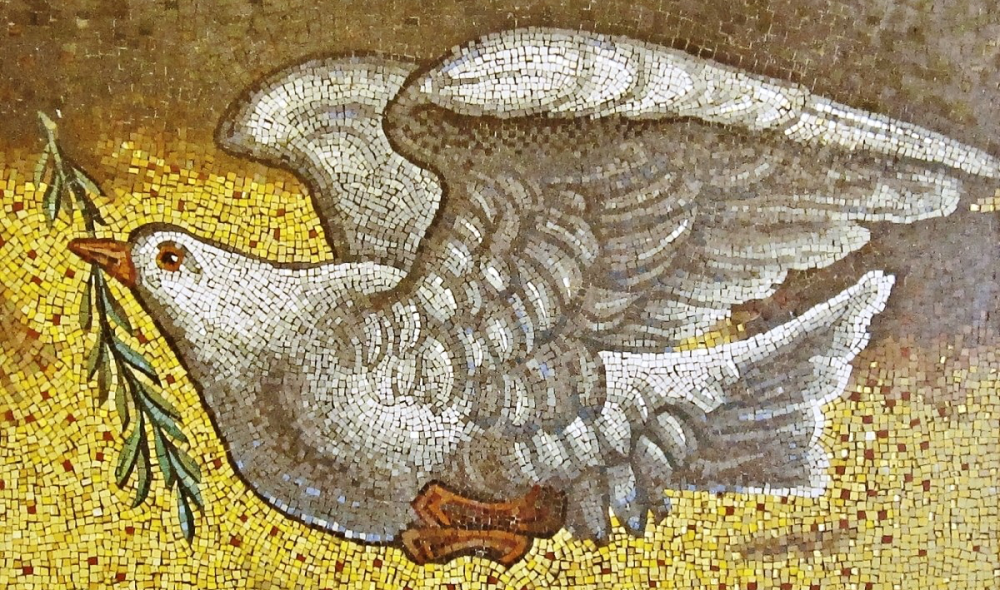
In any case Leviticus 15 concludes: “You must keep the children of Israel separate from their uncleanness, so that they do not die by defiling My tabernacle that is among them. This is the law of him who has a discharge, of the man who has a seminal emission whereby he is unclean, of a woman’s [niddah], of any male or female who has a discharge [zub], and of a man who lies with [niddah].’” As discussed the tabernacle appears to be a vaginal symbol of the Aryan woman possessed by the Jewish Yahweh, hence a racial, sexual jealously lies at the core of this message.
Another metaphor in Leviticus and elsewhere in the Hebrew Bible appears to be, shockingly, leprosy as a metaphor for fair skin. Hence, in accordance with today’s “leftist” public discourse, Whiteness itself is understood as a kind of disease. If one doubts that skin color was not on the mind of ancient Jews they should consider this line from Song of Solomon, where we find a Jewish lover, commonly identified as Yahweh, bedding a northern derived woman from Lebanon. Here she is described as “most beautiful” or Japheth, יָפֶה.
Here again the word beauty itself is a synonym or reference to Japheth who is understood as the ancestor of Europeans. In contrast Yahweh describes himself thusly: “I am black yet lovely, O daughters of Jerusalem, like the tents of Kedar, like the curtains of Solomon. Do not stare because I am black, for the sun has gazed upon me.”[3] We take black here to mean swarthy or dark.
But how do we know leprosy refers to fair skin? References in the Hebrew Bible make this clear. For instance, leprosy is described in Numbers 12 as making Moses’ sister Miriam sheleg, שֶׁלֶג, or “white as snow,” a description used two other times in the Hebrew Bible to describe the condition, whereas in Leviticus, for example, the condition will be described as white or laban, לָבָן in the Hebrew. The reader will remember this is the name of Jacob’s father-in-law, Laban, owner of the white flock, which the proto-Jew, Jacob, deliberately breeds darker so as to possess.
Tellingly Moses’ sister Miriam develops the disease after objecting to his marriage to a Cushite woman. It is a curse inflicted upon her by Yahweh to punish her for this moral failing. If any race might be understood as dark skinned in the Hebrew Bible, more than the Hamites, it is the Cushites. Indeed, the word for Cushite, Kushi, כּוּשִׁי, describing Moses wife is commonly translated as “Ethiopian” in English translations of the Hebrew Bible. In Modern Hebrew it translates as “Negro,” “moor,” “black” even “nigger.” Hence perhaps Miriam is understood as developing a case of toxic “Whiteness.” The aforementioned parable where Jacob deliberately darkens Laban (“white”), white flock of sheep tends to a corroborate a racial message appearing in Leviticus as well.
In Leviticus this leprosy is also described as developing first as “white swellings.” The word here though for swelling is seeth, שְׂאֵת, which may mean “swelling” but also “authority,” “exultation,” “high position,” “majesty” and “uprising.” In fact, of 14 occurrences in the Hebrew Bible, only in the seven appearances in Leviticus is it used to describe a physical swelling as opposed to a metaphorical one. Hence “White swellings” on the body might ostensibly also be translated as “White authority” or “White uprising.”
That the condition is understood as making a person sheleg, שֶׁלֶג or “white as snow” may even be part of a broader metaphor that understands degenerating Aryan blood, if originating in the heavens, as a snow melting in the mountains of Lebanon, feeding the fertile Sea of Galilee, then descending down the Jordan into the salty dead sea adjacent to Judea.
We sense this from this passage in Jeremiah 18:14 where the word sheleg is used: “Does the snow of Lebanon ever leave its rocky slopes? Or do its cool waters flowing from a distance ever run dry?” A similar sentiment is repeated by the “black” Yahweh in the Song of Solomon where he says to his Japheth lover, “You are a garden spring, a well of flowing water streaming down from Lebanon.”[4] The name Lebanon comes from the Phoenician root meaning lbn or Laban, meaning “white.”

The word for leprosy itself, tsaraath, צָרַעַת, appears related to the proper noun Tsorah, צָרְעָה, commonly translated as Zorah. Zorah, ostensibly, was an ancient city in which the Aryan figure of Samson was born. Zorah was also the name of an Egyptian Sun God. Samson’s name means “Man of the Sun.” Hence this word for leprosy in the Hebrew Bible, which we understand as especially dangerous when “deeper than the skin,[5]” is possibly a simple reference to Aryanness. In any case, we can be certain that these meanings are retained in the New Testament when the Jewish Christ “cleanses” a leper by a mere touch. This would be in line with a number of admixture symbols indicated in the Christ cult, including with the crucifixion, baptism, bread and blood wine.
The verb for cleanses in the New Testament, in this context, is katharizó deriving from the noun katharos which means “clean” especially in the spiritual sense. Katharsis or Catharsis meaning “purification” is a noun form of it, which famously was also used by Aristotle to describe the effects of tragedy. It’s possible there is a play on words here. Again this study argues that tragedy, especially as it emerged in the Dionysian cult of Athenian theater, was perhaps often used consciously to demoralize an Aryan host population and that the Dying-and-Rising cults represent an example of theatrically developed tragedy. In any case, we may understand catharsis here as akin to the metaphor developed for Tragedy describing emotions of the “soul.”
There is a possibility as well lepers are indicated as “fish” in the New Testament metaphor among the Christ’s Fisher of Men. This study does argue that fresh water fish, particularly the fish of the Sea of Galilee, represent Aryans as resource. In fact, in Leviticus, we find ritually clean fish with fins and scales listed among other animals, representing breeding resources, as animals that are clean to eat. Here the word for leprous is lepros in the Greek meaning “scaly” and “leprous.” Ostensibly “scaly” describes the physical appearance of leprosy. Yet nevertheless lepros is the adjective form of lepis meaning “the scale of a fish.”
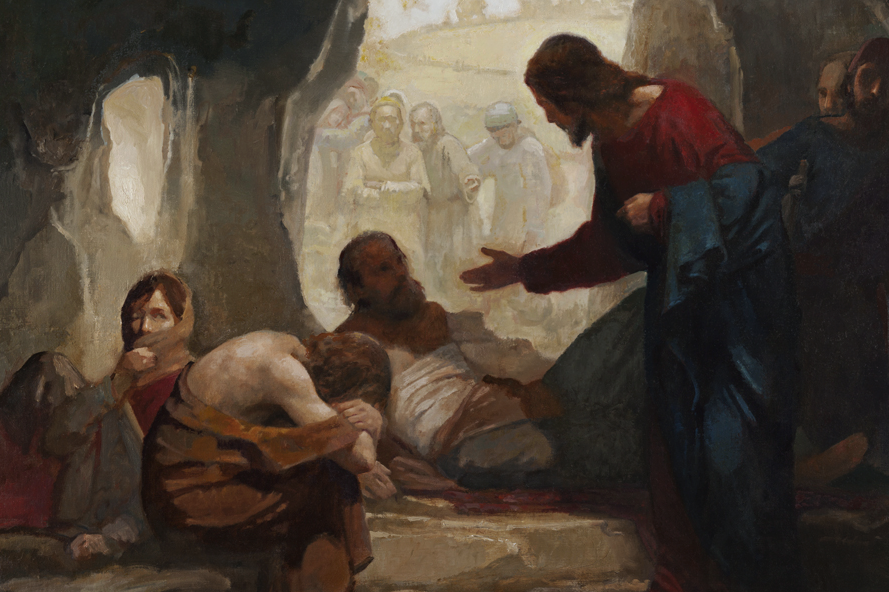
Possibly it’s meaningful that leprosy is also described as appearing with white “sores” or “marks.” Here the word is nega, נֶגַע, meaning “plague,” “infection” or commonly “mark.” This might be a reference to the Mark of Cain or the marks appearing on the followers of the beast in Revelation 13. Hence Whiteness itself becomes a cursed, mark. Though the word for mark is different than that appearing in passages in Genesis, where the Mark of Cain is described. There the word is oth, נֶגַע and may have a meaning closer to “sign” or “letter.” Likewise this study proposes other meanings for the Mark of Cain. For instance, it may be a reference to a Jewish power of language and the esoteric power of naming.
In Leviticus the cure of Leprosy is described as requiring that the hair of the afflicted to be cut off and by sending him out of the camp for seven days. This is a repeated refrain. The afflicted must be ostracized for seven days before being permitted back to camp. The Hebrew word for hair here is sear, שֵׂעָר and we have already discussed this is a vaginal or genital, Aryan symbol. Leviticus also indicates that when the hair and not merely the skin turns White, this is a sign of skin disease or uncleanliness.
As with the Samson parable, circumcision, the separation of Aryan man from Aryan woman, as well as an elimination of “Whiteness” is suggested here. After his seven days away from the camp, the afflicted man is to bring unblemished lambs, grain, fine flour and olive oil to the Tent of the Assembly as offerings to re-enter camp and the good graces of Yahweh’s community.
We’ve discussed these symbols as symbols of the Aryan as consumable as well as the Tent of Assembly as a reference to Yahweh or Jewry’s insemination of the Sarah, the Aryan sacrificial sheep. The sense of sexual competition is strong with the Tent of the Tabernacle. Numbers 1 indicates only Levites were to control the tent, take it down and set it back up again and “anyone who goes too near the tabernacle will be executed.”
Hence if we understand the tent as a vaginal symbol and as a reference to sexual access to Aryan’s, such as Abraham’s Sarah, we see a Jewish sexual will to power that assumes possession of prized, clean Aryan sexual resources, while forbidding them to Aryans. This is done by determining the Aryans “unclean” or with “leprosy” or their relationships “unclean.” This is a process we see repeated by the Jewish media and academy today with the notion of White being inherently guilty or “unclean” because of the crimes of their ancestors. It’s a cheapening and demoralizing of stocks, so as to gain access to them on dominant terms.
It must be pointed out that in Leviticus 13:12 we appear to find a passage that contradicts these ideas, that “white is bad.” For example, there it says: “If the disease breaks out all over their skin and, so far as the priest can see, it covers all the skin of the affected person from head to foot, the priest is to examine them, and if the disease has covered their whole body, he shall pronounce them clean. Since it has all turned white, they are clean.” Does this mean they now represent a clean, White suitable sacrificial lamb for Yahweh in the Tent of Assembly? Likely not.
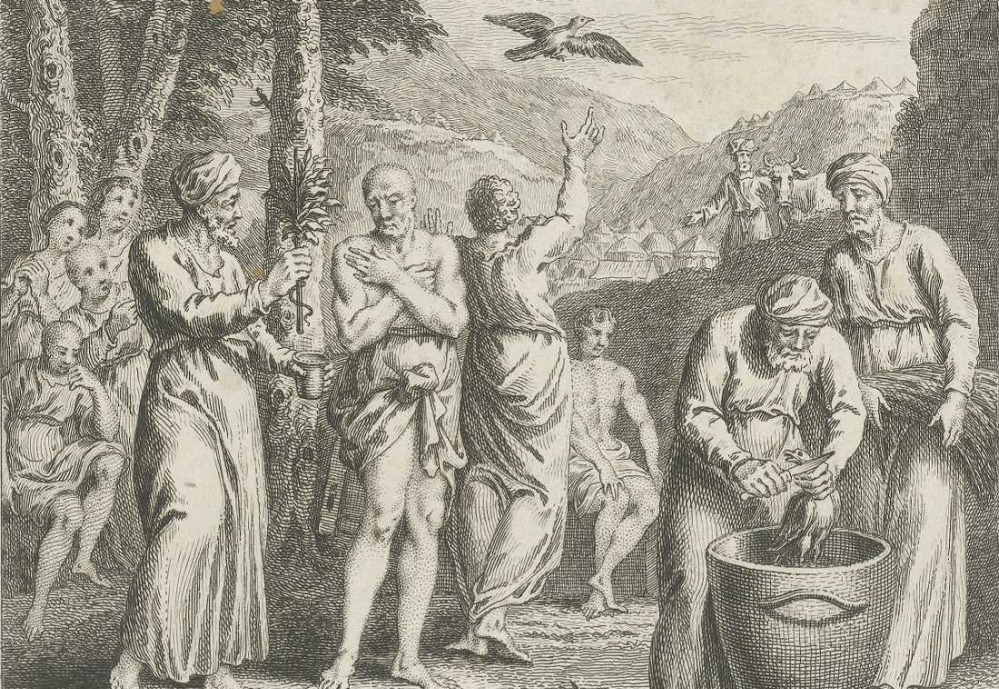
As with the study of all JEM, especially that rendered in Hebrew, a careful reading is required.[6] Leviticus goes on to say: “But whenever raw flesh appears on them, they will be unclean.” In fact earlier it says: “whenever raw flesh appears on someone, he will be unclean.” Here it is important to note that the “raw” in “raw flesh” is chay, חַי, meaning “alive,” “living.” It’s a word related to the Hebrew word for the Aryan figure Eve, Chavvah, חַוָּה, meaning “life,” who is the “mother of all living things.” Hence Leviticus is saying whenever “living flesh” is on them, they will be “unclean.”
It goes on: “when the priest sees the [living] flesh, he shall pronounce them unclean. The [living] flesh is unclean; they have a defiling disease. If the [living] flesh changes and turns white, they must go to the priest. The priest is to examine them, and if the sores have turned white, the priest shall pronounce the affected person clean; then they will be clean.” Here the word that is interesting to us is the word used for “turn” as in “turned white.” It is haphak, הָפַךְ, which may mean “turn” or “perverted,” “overturn,” or “overthrow.” Hence the passage could as easily be read “if the sores have overthrown white, the priest shall pronounce the affected person clean.” Again, the word for White here is laban. This is as well the name of Jacob’s Aryan father-in-law, effectively “overthrown” by Jacob, by darkening his white flock.
Likewise this would be more consistent of a view of a white skin coloration shown throughout the main of Leviticus’ discussion on “leprosy” as well as, of course, JEM more generally. Thus, potentially, a nice red herring is built into Leviticus. But as mentioned the language is deliberately deceptive here and must be examined closely.[7] Another word used to describe these sores in Leviticus is bahereth, בֹּהֶרֶת, which means “bright spots.” In the Modern Hebrew, interestingly, it translates as “brightness,” “clarity” and “clearness.” The etymology of this word may suggest the diurnal.
This is worth pointing out as we may see one possible reference to these spots of leprosy in contemporary Cinema. In the 2019 film the Joker, written by Todd Phillips and Scott Silver, the Joker’s real name is Arthur Fleck. The name fleck means patch or spot. More the word fleck may mean “a spot or small patch of color, light etc” or even “a spot or mark on the skin.” The film has commonly been understood as having developed the Joker character as a reference to racially displaced, white “incel” gunmen. This appears to be the case. Here mutli-generational societal problems are ultimately responsible for the Joker’s mental illness.

In fact, in the manner Stan Lee’s Mary Jane Watson emerges as a deity or embodiment of Marijuana and Bacchus as an embodiment of wine, the Joker emerges as the embodiment or God of “whiteness as disease.” The film makes clear that opiates in the form of anti-depressants are the cure here. It even insinuates the Joker will “not be clean until ‘evening’ or admixture” with the introduction of a longed for African American love interest. This theme appears repeated with multiple black mental health workers who administer his anti-depressants finally “quarantining the disease” in an insane asylum. But of course, whether Christianity, drugs or pornography, opiates are always the cure offered by the serpent Gods Asclepius and Bacchus.
In Leviticus 14:34 it describes how the Jewish priest must go into the houses of the land where Yahweh has place a nega, נֶגַע, or a “plague” or “mark” of leprosy (tsaraath). Commonly the English translation of leprosy here is “mildew.” If mildew consists of red or green depressions or “hollows” and has spread onto the stones of the house the affected stones must be thrown in an unclean place outside of the city. This is if the problem hasn’t resolved itself after the house has been sealed for seven days. Different “unaffected stones” will then be used to replace the discarded ones.
The word for red here though, adamdam, אֲדַמְדָּם, meaning red or more commonly reddish-white or pink, is likely a reference to the Aryan figures of Adam, a word meaning man, or Esau. Pink is perhaps a reference to an Aryan, non-Semitic complexion. The word for green here yeraqraq, יְרַקְרַק, means “greenish,” “glistening” or “green pale” and appears related to yeraqon, יֵרָקוֹן meaning “mildew,” “paleness” or “lividness.” To be certain though, a motif will appear in JEM, where the combined colors of Green and red, as appearing with the symbol of the rose, indicate admixture. This is perhaps being suggested by the priest entrance and “inspection” of the house which may also be understood as a vaginal symbol here.
Afterward the inside of the house is to be scraped of its “dust” or “plaster” and this plaster is to be dumped in an unclean place outside the city. Here the word for dust is aphar, עָפָר, meaning “dust.” It is perhaps meaningful that this same word is used to describe the substance by which the Aryan figure Adam was made in Genesis 2:7 and which the Semitic serpent is condemned by Yahweh to eat. If the leprosy cannot be eliminated from the house, stone, timber and all, it is to be torn down and dumped in an unclean place outside the city. Assuming we have deciphered the metaphor correctly, the desire to displace, condemn and even ostracize Whites is striking. Leviticus 13:45 says:
“The diseased person must wear torn clothes and let his hair hang loose, and he must cover his mouth and cry out, ‘Unclean, unclean!’ As long as he has the infection, he remains unclean. He must live alone in a place outside the camp.” Here, as in today’s society, Whiteness is understood as a “dangerous” perhaps even a “disease,” no one is permitted to defend it. Certainly this is the case so far as anyone desires to see Whiteness continued into the future. Hence a policy of social ostracism is described. People exhibiting signs of “leprosy” are to be ostracized. This is precisely what we see today. It makes us wonder if the Ainu of Japan, with their unique genetics, represent a remnant of a similarly demonized and ostracized Aryan founding race.
Here is the simple truth of the matter. Leviticus is a letter of intent and game plan for pathologizing “Whiteness.” The understanding here is that Yahweh or Jewry, through the authority and mystery of the curtained Tabernacle, or Media, Art and Religion, can control and demoralize Whites by convincing them that they are “ritually” or “morally impure” and may only be made pure through intermixture.

Similar laws that are applied to the appearance of “mildew” in houses are developed in Leviticus to treat the appearance of leprosy or “mildew” on fabrics. The fabrics specified here are linen or flax, wool and “skin” or or, עוֹר, commonly translated in English as leather. There is says: “If any fabric is contaminated with mildew—any wool or linen garment, any weave or knit (or woof) of linen or wool, or any article of leather—and if the mark in the fabric, leather, weave, knit, or leather article is green or red, then it is contaminated with mildew and must be shown to the priest.”
Here we remember Galilee, the “Whitopia” of the Biblical works, means also “cylinder,” “roller,” “spool,” “province,” “district,” and “region.” Possibly there is a distaff metaphor here which would be corroborated by Hebrew words like pelek, פֶלֶךְ meaning “whorl of spindle,” “district” or “region” in the Ancient Hebrew. Here it is important to note that the word pelek appears in the Hebrew Bible twice as a reference to distaff, while six times in the book of Nehemiah as a reference to districts specifically in the city of Jerusalem. Hence pelek might be better understood as a “district of Jerusalem” or “district of Judea.”
Thus a metaphor may emerge, where we find Northern Aryan or Galilean wool being collected or wound into a Jewish whorl or city. It may in some sense be a metaphor for the country dwelling Esau or Japheth being drawn into the cities to live in the tents of Jacob and Shem. The urbanization of later stage civilization[8] or megalopolis that Spengler describes becomes relevant. Though the metaphor is not wholly distinct from the idea of Northern flowing Aryan waters gathering in a Jewish salted sea at least in apparent meaning. The Modern Hebrew adds another striking dimension to this. There the word for spindle, the instrument upon which the wool is wound, is Kush, כּוּשׁ, or “Ethiopia” and “spindle.” Thus we see an idea of wool being wound in a darker direction and other clues will point to this in the fabric metaphor.
Of course we already know wool, to the extent it is a symbol of sheep, to also be a symbol of Aryans, if now “processed.” Hence it makes sense that Galilee is understood as the spool from which the wool is drawn. It may be possible flax shares a common symbolic root with Linus, an important son of Apollo. After all the name Linus means “flax” and he may be meant to symbolize this plant, in the manner Kore symbolizes wheat. Linus appears to be a wholly Aryan figure commonly descended of Apollo and the head of the Muses Calliope.
Though the most interesting word appearing in the passage above is the word for knit or weave. It will sound familiar. It is ereb, עֵרֶב, meaning “Arabia,” “mixture” or “mixed company.” In the modern Hebrew it means “evening.” Here we assume fabric or beged, בֶּגֶד, already represents a “multicultural” society where an Aryan “wool” has been drawn into “Jerusalem” and remade, possibly upon a Cushite spindle. Perhaps it is meaningful beged also means “treachery” in the Biblical Hebrew.
Here of course there is a striking sense of “social engineering” and Jews as the Chthonic fates weaving the fates of men, with perhaps each thread representing a man or woman, woven into a larger “multicultural tapestry” or fabric. Though it is often incorrectly said the Fates are more powerful than even the Gods, these bitches should remember that even wily Homer acknowledges Jupiter holds domain over the Fates. In Latin we have the word axis, that may mean “spindle,” “region” but also “sky,” abode of the Aryan Gods. This is the spindle upon which the wool now winds.
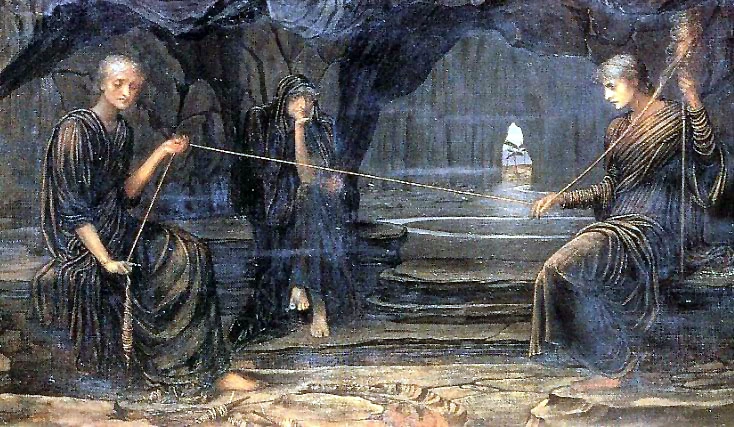
It seems almost certain, of course, the desire to eliminate “leprosy” here from “fabrics” described in Leviticus is the desire to eliminate Whites from the fabric of a Yahweh or Jewish dominated society. Here the metaphor is one of “cleansing.” Indeed, while it may be difficult to pinpoint the ultimate origin of the modern term “ethnic cleansing, ” or to determine whether it arrives to us via Promethean Transmission, it is, nevertheless, evident that Jews had already developed this notion long ago. Here though, the subject of this cleansing was Aryans, understood as a disease. Hence Christians should understand that when the Jewish Susan Sontag said “The White race is the cancer of human history,” her arguments were Biblically sound, even if she had altered the metaphor slightly. [9]
But how is this “clean” “mixed” “dark” societal fabric developed? Doubtlessly it is woven from the animals slaughtered in the Tent of Meeting. And here we encounter another Jewish senses of “cleanliness,” even “Holiness.” According to the Biblical accounts, within the Tent of Meeting there was second curtain behind which the sacrificial animals where brought. It contained the Aryan vaginal symbol of the gold-covered ark with a gold jar of manna within it. The ark as well contained the Semitic phallic symbol of Aaron’s staff. A staff that could turn into a serpent and a staff that “had budded.”[10] This room was called the Most Holy Place. Here we begin to discern clearly Jews as descendants of the architects of all the major Sacred Whore Cults that have graced this planet since Sumer, from the Dumuzid Cult to the Catholic Church, to Hollywood, to the porn industry.
The word for Holy here is qodesh, קֹדֶשׁ, which means “apartness,” “sacredness,” and “sacrificial.” Qodesh is also the root of the closely related qadosh, קָדוֹשׁ, meaning more simply “sacred” or “holy.” Interestingly qodesh is also the root of qadesh, קָדֵשׁ, meaning a “male temple prostitute.” It is also the root of the feminine equivalent qedeshah, קְדֵשָׁה, a word that means whore in the Biblical context. Here, in the Biblical context, we understand animal sin offerings, which we understand clearly as metaphors for human beings, to be qodesh or “most holy.”
The Modern Hebrew tends to confirm our suspicions. There the Biblical word for whore, qedeshah means simply “holiness” or the verbs “sanctify,” “consecrate,” “hallow” and “bless.” The word for male temple prostitute, qadesh, means simply “holy” in the Modern Hebrew. Why would the careful curators of that language allow this? Yet it is, of course, consistent, based on our knowledge of Jewry and our rapidly expanding knowledge of JEM.
After all, our study reveals that, indeed, catamites such as the Biblical Jonah and Elisha are vital as corrosives to out-groups while serving as cohesive for a Jewish core where hiding, persecuted men are “in love,” whether physically or “platonically,” with one another and out-group alike. Yet simply saying Jews have an inverted morality or at least inverted sexual morality fails to understand the entire phenomenon and leaves us with the childish explanation that Jews are simply “evil.” No. Nothing in nature is evil. This is true even if the wolf tends to believe the hunter evil, while the rabbit tends to believe the wolf evil. Jews are a Semitic Bride Gathering Cult.
That the Tent of the Meeting is where Yahweh or Jewry gains sexual access to “Israelite women” is made clear in Numbers 5. There Yahweh commands Moses to gather all the women among the Israelites that are suspected by their husbands of being adulterers and of course “having them stand before the Lord.” There the husband must bring a grain offering for jealousy to Yahweh while the priest prepares a vessel of bitter water by sprinkling dust from the tabernacle floor into holy water in a clay pot.
The priest then tells her: “‘If no other man has slept with you and you have not gone astray and become defiled while under your husband’s authority, may you be immune to this bitter water that brings a curse.” In the event she is guilty he announces “May this water that brings a curse enter your stomach and cause your belly to swell and your thigh to shrivel. But if the woman has not defiled herself and is clean, she will be unaffected and able to conceive children.” He then makes her drink the water. The word for “cause to drink” is shaqah, שָׁקָה, and it may mean “water” or “irrigate.” The word for “thigh” here yarek, יָרֵךְ, may mean “lions,” the word translated “shrivel” here naphal, נָפַל, most commonly means “fall.”
In Isaiah 26:18-19 it is commonly translated into the English “born,” or “give birth” but this is unusual. In the Modern Hebrew, somewhat ambiguously, it may mean “abortion” or “untimely birth.” Yet even if we accepts that this means she will miscarriage as opposed to give birth it seems evident that the bitter water that will cause her “belly to swell” is a reference to semen while the clay pot a womb or vaginal symbol. The Tanis root drink that is prescribed to Rosemary in the 1966 Polanski film Rosemary’s Baby, to keep her and her “Satanic” baby healthy prior to her pregnancy, may be a reference to this scene.
Likewise, bitter water perhaps suggests, salted or Semitized semen. This is especially true understanding the influence of the Sumerian symbol of ab on Jewish symbolism. The clay pot may as well suggest the racial admixture found in the clay feet of the colossus appearing in Daniel. Likewise whether the woman miscarries or is “able to conceive children,” it seems evident the Priest is attempting here to be the father.
Of course it makes sense that the wayfaring people of Jews would find the promiscuity of native women, whom are often the wombs that continue them “sacred.” Hence from one perspective the Whore of Babylon in Revelation is an ominous portent. She is a symbol of civilizational decline, degeneration and “Apocalypse.”
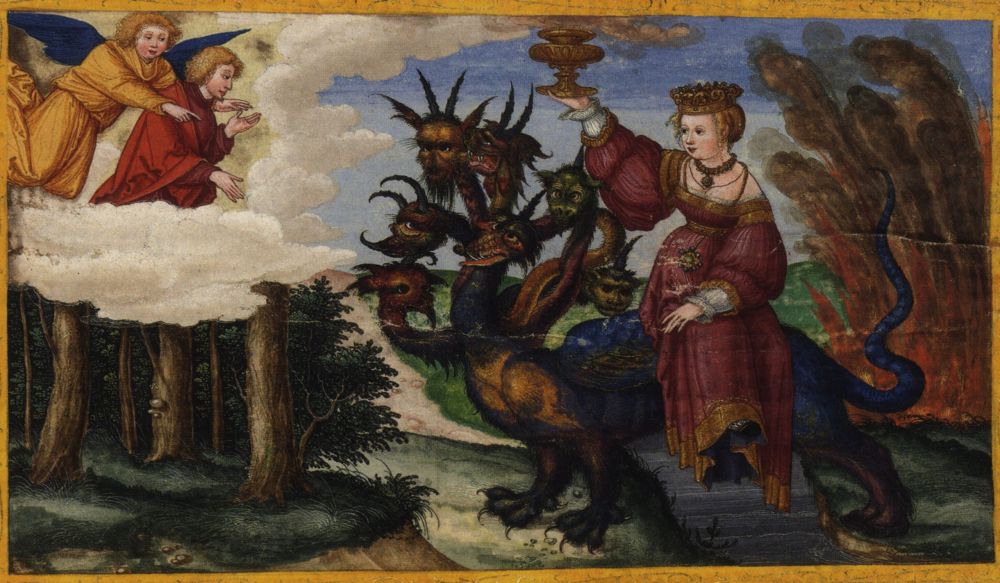
From another perspective she is “milk and honey,” “holiness,” a sight for sore eyes, the moment when the “Son of Man” begins to “reap his harvest” as described in Revelation. There she “rides” a seven headed beast, wrongly guessed to represent the seven hills of Rome. The number seven as already mentioned is a common bit of Jewish numerology that appears to reference the reaping God Saturn. Her relationship to the “seven headed beast” is sexual.
Though we shouldn’t doubt that Jews are so stupid and unwise as not know the result of the appearance of the Sacred Whore, who may not be “slut shammed.” Yahweh’s judgment against Nineveh beginning in Nahum 3:3 sums it up:
“Charging horseman, flashing sword, shining spear; heaps of slain, mounds of corpses, dead bodies without end—they stumble over their dead— because of the many harlotries of the harlot, the seductive mistress of sorcery, who betrays nations by her prostitution and clans by her witchcraft. ‘Behold, I am against you,’ declares the Yahweh of Hosts. ‘I will lift your skirts over your face. I will show your nakedness to the nations and your shame to the kingdoms.’”
The word for nation above is “goy.” Yahweh is distinct from nation or “goy.” Hence why would he care? In Leviticus we begin to see that the process of racial and civilization degeneration is not in any manner “wholly natural,” as insinuated by Spengler, but rather a project pursued actively by proto-Jews, Jews and post-Jews. As others have said, they are dutiful “managers of decline,” believing themselves God himself. To challenge them we will form a similar belief.
[1] Here, it should be made clear, the first letter in each word is different. Tame begins with a t sound deriving from the Hebrew letter teth, ט, while the t-sound in tanim derives from the letter taw, ת. The connection here is speculative. The word tannin, תַּנִּין, meaning “serpent” or “dragon” is phonetically similar, it could be argued, and shares the first letter with tamim. Yet the symbolic meaning of the “serpent” is Semitic, while tamim, this study argues, relates to an Aryan purity.
[2] Ab, אָב, means “father.”
[3] Song of Solomon 1:5 “I am black, yet lovely, O daughters of Jerusalem, like the tents of Kedar, like the curtains of Solomon. Do not stare because I am black, for the sun has gazed upon me.” Christians commonly assert this is a description of the woman and not the man (presumed to be Yahweh) in the poem. However no evidence suggests this. Though it is clear that the poem is a dialog between lovers, speakers are not identified from this passage to that. While scholars are able to reach consensus on later passages of the poem as to which speaker is speaking, 1:1–6 is commonly classed “introduction” while 1:17 -2:7 simply Dialogue between lovers. The speaker is addressing the daughters of Jerusalem. Perhaps this suggests a male perspective particularly in the context of a love poem where the male is understood a courter. Likewise 1:6 indicates the speaker a vintner, a male profession in the ancient world, arguably equating him the Semitic Bacchus as was Yahweh by ancient mythographers. Elsewhere in the poem the female, possessing breasts or “shad,” שַׁד, is praised as “fair” or Japheth such as in 4:1. There experts are in agreement, the man is addressing the “Japheth” women. All of this, of course, is weighed against a consistent self-perception appearing in Jewish Esoteric Moralization, where Jews commonly feel themselves to be the darker man vying for fairer stocks.
[4] Song of Solomon 4:15
[5] Leviticus 13:3
[7] The deeply subversive Leviticus in particular is full of red herrings and wears its stern “morality” on its sleeve especially in Leviticus 19. Yet esoterically it will condone many of the things it condemns. These passages are treated specifically, elsewhere in this study.
[8] World-wide we see an increase trend toward urbanization. The United Nations in 2009 and the International Organization for Migration in 2015 both estimated around 3 million people move to cities every week. Around 54% of people worldwide now live in cities, up from 30% in 1950.
[9] Footnote forthcoming .
[10] Hebrews 9:3

Mighty Mark.. thanks.
LikeLiked by 1 person